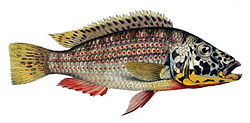| Ctenochromis | |
|---|---|
 | |
| Ctenochromis horei | |
| Scientific classification | |
| Kingdom: | Animalia |
| Phylum: | Chordata |
| Class: | Actinopterygii |
| Order: | Cichliformes |
| Family: | Cichlidae |
| Tribe: | Haplochromini |
| Genus: | Ctenochromis Pfeffer, 1893 |
| Type species | |
| Ctenochromis pectoralis Pfeffer, 1893 | |
Ctenochromis is a genus of haplochromine cichlids endemic to the Lake Tanganyika and Congo River basins in Africa.
At present, 5 species are validly described in Ctenochromis: [1]
- Ctenochromis horei (Günther, 1894)
- Ctenochromis luluae (Fowler, 1930)
- Ctenochromis oligacanthus (Regan, 1922)
- Ctenochromis pectoralis Pfeffer, 1893– Pangani Haplo (listed as extinct by the IUCN, but this appears to be incorrect). [2]
- Ctenochromis polli (Thys van den Audenaerde, 1964)
An undescribed population that appears to be a distinct species is: